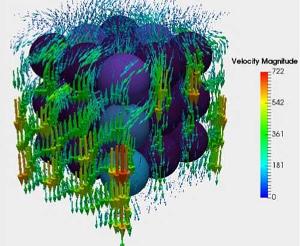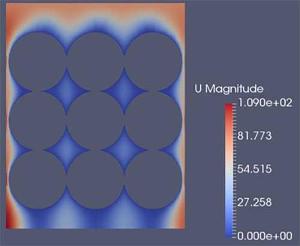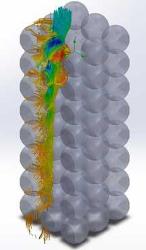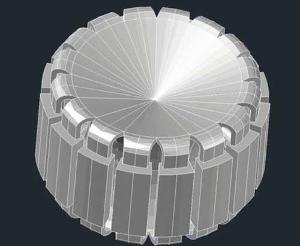Type of Research
-
Thermal Transport in Nuclear Fuels using Atomistic Simulations
Efficient thermal transport in nuclear fuels is an important research topic that is directly related to the life-time of nuclear fuels. During the operation of a nuclear reactor, a large temperature gradient is induced in nuclear fuel pellets; the temperature at the center of fuel pellets becomes much higher when compared to the temperature at the outer shells of the pellets. This large temperature gradient generates thermal stresses that generally result in cracks in fuel pellets. Moreover, the hot spots in fuel pellets increases the rate of fission gas release and can cause fuel pellet swelling, due to fission gas bubbles and thermal expansion. Fission gas release degrades the fuel’s mechanical quality further by causing embrittlement in grain boundaries. Therefore, thermal transport study is an important research topic in nuclear fuels.
NESEL researchers have employed molecular dynamics simulations to explore thermal transport in various oxide nuclear fuels with defects such as uranium oxide and plutonium oxide. In particular, the effect of vacancy and substitutional defects on the thermal transport in actinide oxides have been investigated. It has been found that the thermal conductivities of these oxide nuclear fuels are significantly reduced by the presence of vacancy defects. In spite of their small size, oxygen vacancy is shown to alter the thermal conductivity of oxide fuels greatly; 0.1% oxygen vacancy reduces the thermal conductivity of plutonium dioxide by more than 10% when the number of unit cell in length is 100. It has been shown that the missing of larger atoms alters the thermal conductivity of actinide oxides more significantly. For the case of uranium dioxide, 0.1% uranium vacancies decrease the thermal conductivity by 24.6% while the same concentration of oxygen vacancies decreases the thermal conductivity of uranium dioxide by 19.4%. However, the uranium substitutional defects are shown to have a minimal effect on the thermal conductivity of plutonium dioxide because of the small change in the atomic mass.
NESEL researchers are expanding their thermal transport study to different nuclear fuels such as Molten Salt Reactor nuclear fuels that are drawing attention from researchers these days. The goal is to obtain a microscopic understanding on the thermal transport in these nuclear fuels and propose optimized structures for these nuclear fuels, so they may exhibit efficient thermal transport properties while maintaining their fuel efficiency.
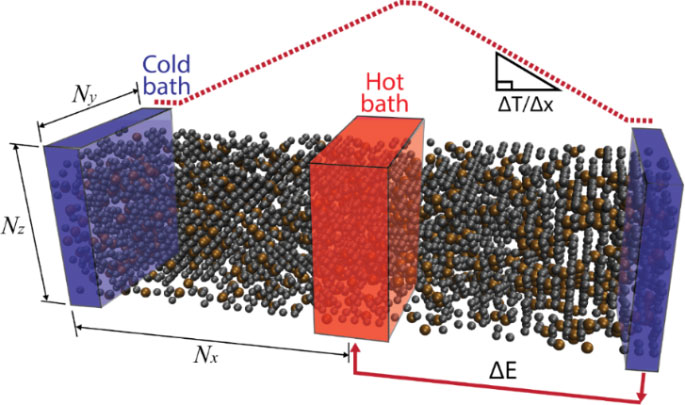 Schematic of sample preparation for Reverse Nonequilibrium Molecular Dynamics (RNEMD).
Nx and Ny denote the number of unit cells in x and y directions, respectively. Ny
is chosen to be the same as Nz in the present study. Nx is selected to be the half
of the total number of unit cells in the x direction since the characteristic length
for thermal conductivity estimation during RNEMD is the distancebetween the hot bath
and the cold bath, not the total simulation box length.
Schematic of sample preparation for Reverse Nonequilibrium Molecular Dynamics (RNEMD).
Nx and Ny denote the number of unit cells in x and y directions, respectively. Ny
is chosen to be the same as Nz in the present study. Nx is selected to be the half
of the total number of unit cells in the x direction since the characteristic length
for thermal conductivity estimation during RNEMD is the distancebetween the hot bath
and the cold bath, not the total simulation box length.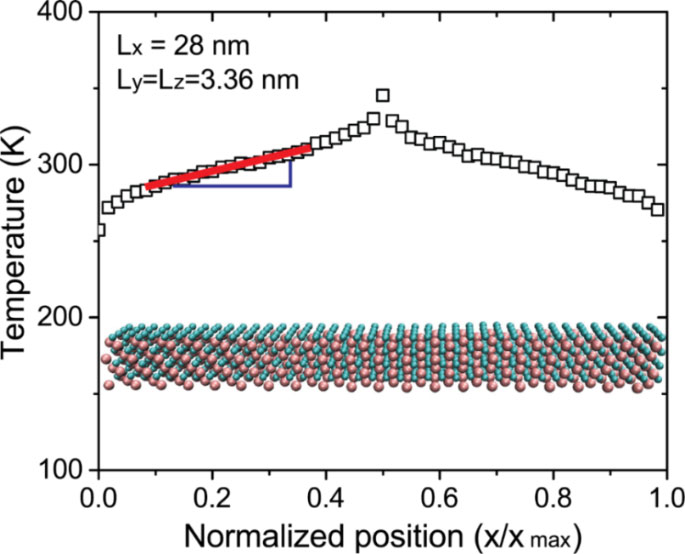 A representative temperature profile during RNEMD simulation. The thermal gradient
is obtained from the linear portion of the temperature profile using the linear regression
function in MATLAB.
A representative temperature profile during RNEMD simulation. The thermal gradient
is obtained from the linear portion of the temperature profile using the linear regression
function in MATLAB.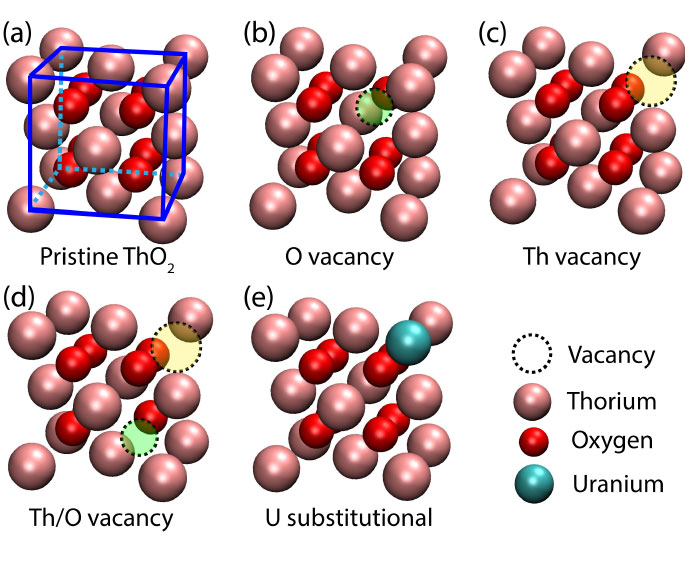 Various defects in the unit cell of ThO2.
Various defects in the unit cell of ThO2.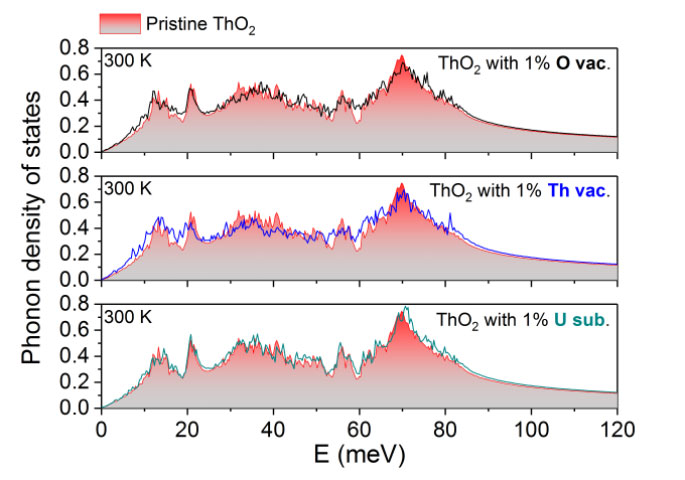 Phonon density of states of ThO2 with oxygen and thorium vacancy defects, and uranium
substitutional defects.
Phonon density of states of ThO2 with oxygen and thorium vacancy defects, and uranium
substitutional defects. -
Computational Fluid Dynamics Analyses of Pebble Bed Reactor and Molten Salt Reactors
Computational Fluid Dynamics (CFD) is a numerical technique to analyze fluid flow and phenomena. CFD technique is widely applied across different engineering disciplines, including Civil Engineering, Mechanical Engineering, and Nuclear Engineering. NESEL students have the opportunity to be involved in research using the CFD technique to simulate different types of flow phenomena. Among the projects, that NESEL researchers are currently working on simulations of Pebble Bed Reactors (PBRs) and, more recently, the Molten Salt Reactors (MSRs).
Pebble Bed Reactor (PBR)
NESEL CFD researchers have modeled the fluid flow within the pebble bed reactor and will continue this effort throughout this year. The goal of this study is to evaluate the possibility of enhancing the performance of the PBR by making adjustments to pebble size and arrangements. PBRs are more cost efficient when heat transfer is optimized. In a pebble-bed reactor, optimizing heat transfer involves the analysis of complex flow. Therefore, CFD is being utilized to simulate fluid movement in a structured cubic packing arrangement with a purpose in finding an optimal size of pebbles that will yield the fastest heat transfer rate. The simple cubic pebble arrangement has been used to determine if pebble size was key to optimizing heat transfer in the reactor. More complex arrangements of pebbles have also been used as comparison to the simple cubic packing in order to determine if changing pebble size in new arrangements were just as significant in its effects towards heat transfer characteristics. An additional purpose to this work has been to observe the effect of pebble packing on the temperature, velocity, and pressure distribution around the pebble. To study only the effects from the arrangement of pebbles, the simulations consist of the standard six-centimeter pebbles in different packing arrangements with a fixed inlet velocity and a fixed pebble surface temperature. To study the effects of pebble size, the standard six-centimeter pebble was reduced to three centimeters in diameter for each arrangement. The key packing structures being considered are simple cubic packing, body centered close packing, and hexagonal close packing.
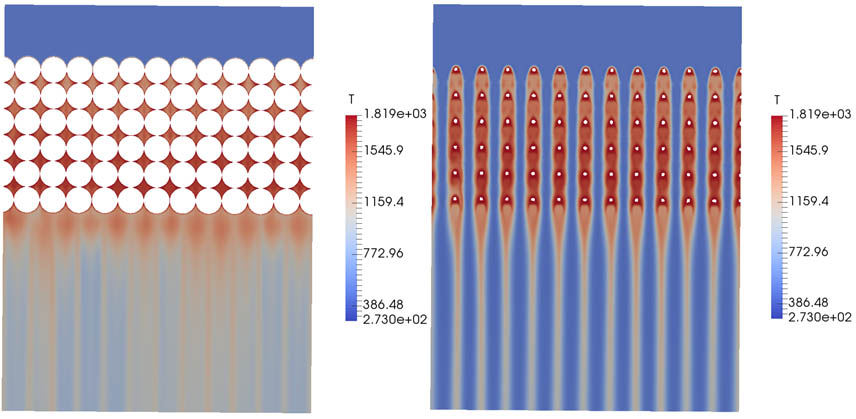
Temperature distribution of pebble bed reactor taken at two different locations (one cutting through the center of the pebbles and the other cutting through void space) Molten Salt Reactor (MSR)
The purpose of this research is to observe how fluid flow, rheology and geometry of the reactor affects temperature profile within the reactor. MSRs are a generation IV reactors that have been selected by the World Nuclear Association for their potential in the advancement of reactor sustainability, economics, safety, reliability, and proliferation-resistance. MSRs were originally designed in the 60s by the U.S. Department of Energy’s Oak Ridge National Laboratory and have recently gained popularity because of their economic and technological advantages. Since this prototype’s introduction to the world, there have been multiple additions to the MSR family. These additions include different arrangements, fuel compositions, and power outputs. Literature shows differing mixed composition of uranium and flouride salts being utilized in the reactor core. Depending on the mixed composition, each mixture has different effects on the core overall temperature distribution. Temperature distribution within the reactor is important due to safety concerns. In addition, the overall output temperature determines the power output and efficiency of the reactor. This research effort involved studying the temperature variation in MSRs when different salt mixtures are used. NESEL researchers have used CFD to study the influence of the different mixtures on temperature distribution and geometry in homogenizing the flow velocity within the reactor. This research may lead to a more reliable, efficient and safer MSR reactor design.
-
Reactor Core Design, Analysis, and Simulation
One of the NESEL research focuses is an exploratory exercise of the nuclear attributes of molten salt fuels in MSRs; particularly, fluoride-based thorium salts and the feasibility of their use in nuclear reactors. A scoping analysis is being performed to look at the behavior of molten salts in various reactor core geometric configurations, such as a cylindrical core of various dimensions and core arrangement in a repeated lattice structure. The Monte Carlo N-Particle Transport Code (MCNP), developed by the Los Alamos National Laboratory, and OpenFOAM are being used for MSR simulations. In conjunction with other NESEL research projects, this study is part of an effort to provide integral data for the completion of a comprehensive study of MSRs, their fuels, and the potential part they play for the future of the nuclear power industry.
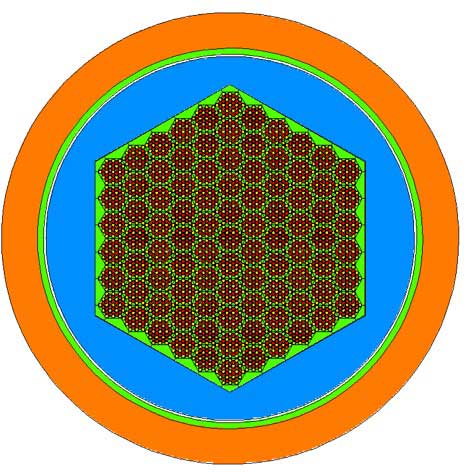
Core layout of a graphite moderated, micro-reactor concept. Full core view (without control drums/elements).
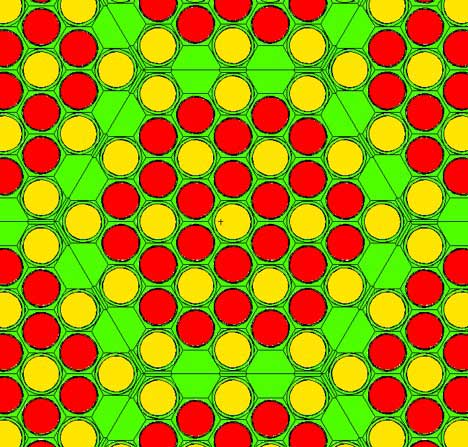
Core layout of a graphite moderated, micro-reactor concept. Full core view (Up close view of each lattice hex).
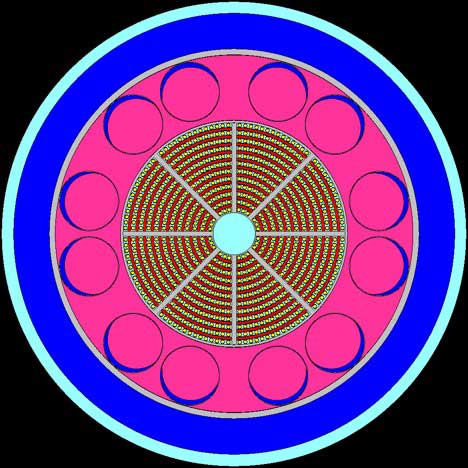
Heat pipe-cooled, fast micro-reactor design using curved fuel plate elements.
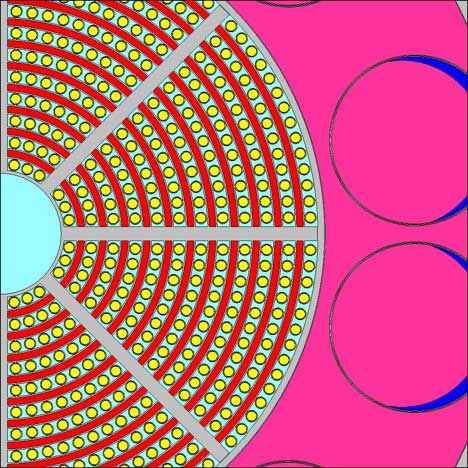
Section of Heat pipe-cooled, fast micro-reactor design using curved fuel plate elements.
-
Radiation Detector Development, Testing and Simulation
Fully functional radiation detectors have been developed, calibrated, and tested using various beta and gamma radiation sources – including phosphorous-32, cobolt-60, cesium-137, and americium-241. The calibration is completed using calibrated rate meters. The detectors are compact and rugged. They can be wirelessly connected to a smart phone, tablet, or computer for data transmission. A general-purpose Monte Carlo N-Particle (MCNP) code has been used to simulate the developed detectors for various radioactive sources and source-detector geometries. The simplicity and cost of the detectors make them ideal detection devices for use in radioactively contaminated areas while allowing the monitoring of dose rates and cumulated dose levels from a distance, due to its wireless capabilities.
-
Radiation Mapping Prototype DevelopmentMost current radiation detection technology only works in a “you’re getting warmer/colder” functionality. The detection technologies currently available that generate an image, offer either a still image – whose film must be removed and developed – or a video image using a cost-prohibitive camera, the weights of which can limit its portability and functionality. No cost effective and reasonably mobile solutions for gamma imaging exist. Such technology has a wide range of possible applications including, but not limited to, shipping container safety scanning, nuclear contamination evaluation, nuclear medicine, non-destructive testing, and general nuclear physics research. By leveraging the existing technology, such as digital sensors, a live video gamma detector could be developed using pinhole camera construction of various designs. The pinhole camera must be constructed of a material that would not permit gamma radiation to pass outside the hole. The material of choice for this use include materials with a high atomic numbers such as tungsten and depleted uranium. The development of these devices include simulations using MCNP (Monte Carlo N-Particle Transport Code).
-
Neutron Facility Simulations
The development of a neutron source facility is being considered at Kennesaw State University (KSU). A californium-252 source will allow researchers at KSU to complete a number of experiments, including activation of samples. The neutron source will be encased in a stainless steel capsule surrounded by water, which will be contained in a larger vessel and located in the middle of a room. The walls of the room will be made of concrete that will form a maze. In addition, concrete shielding will be added to the ceiling and floor to minimize ski-shine and ground-shine effects, respectively. The facility should be tested for safety and functionality before any construction is done.
A general-purpose Monte Carlo N-Particle (MCNP) code has been used to simulate neutron transport to determine the neutron shielding properties of water and concrete. This information has been analyzed to determine the unique depths of concrete and water that are safe enough for the public. This information has been used to simulate a safe neutron source facility within a general-purpose Monte Carlo N-Particle (MCNP). The facility is a room within a building; however, the concrete walls and water container will be added to the existing structure. During the simulations, various detectors have been placed around and inside of the facility at critical points within the simulation to measure radiation. The neutron source facility simulation yield results that indicated that the operation of the facility is safe for the public (less than 0.1 rem/yr) and facility staff (less than 5 rem/yr).

MCNP simulation of sealed californium-252 source located in the middle of the blue water container. The red dots represent locations of dose and dose rate measurements.
-
Tritium Control using Novel Nanomaterials
Tritium is a radioactive isotope of hydrogen that has a detrimental health effect in humans. Advances and growing interests in molten salt reactor fuels demand more research efforts for tritium generation and the efficient control of such hydrogen isotope. Graphene is a single layer of graphite that possesses a highly efficient thermal transport property and high mechanical strength. We utilize molecular dynamics simulations to investigate the possibility of using graphene for tritium control.
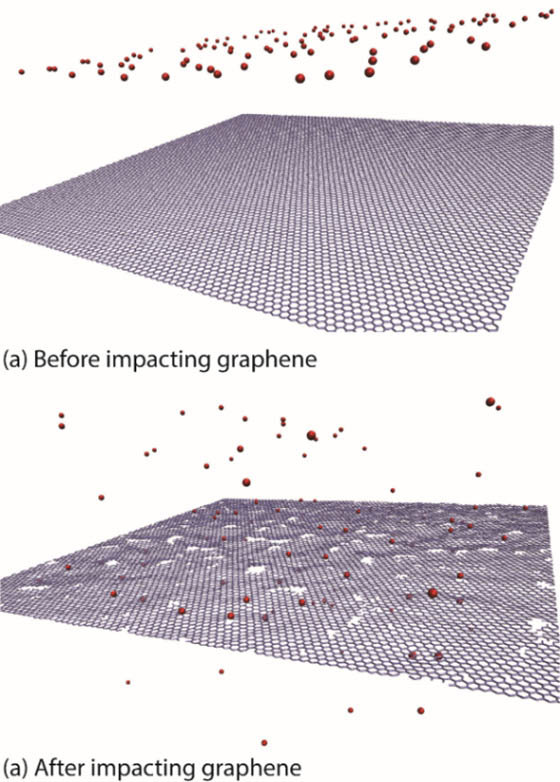
Simulation structure of graphene with 100 tritium atoms (a) before impact and (b) after impact. -
Thermal Transport in Molten Salt Reactor Fuels
Molten salts are expected to play a vital role in future nuclear power technologies. For example, molten salts can be used as a nuclear fuel for molten salt reactors and as a coolant for high temperature reactors. Microscopic understanding on the thermal transport of such materials is critical to the optimization of them for fuel efficiency and safety. We utilize molecular dynamics to explore the thermal transport properties of a LiF-ThF4 mixture that is a representative molten salt reactor fuel candidate.
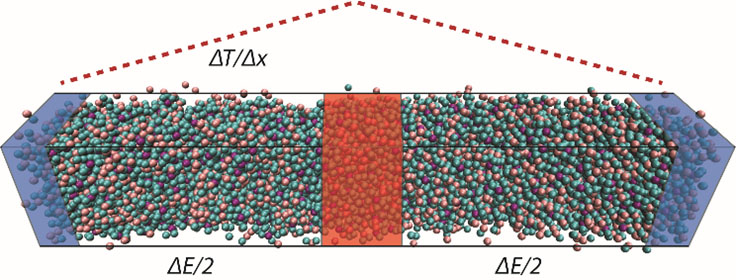
Simulation structure of LiF-ThF4 during RNEMD. 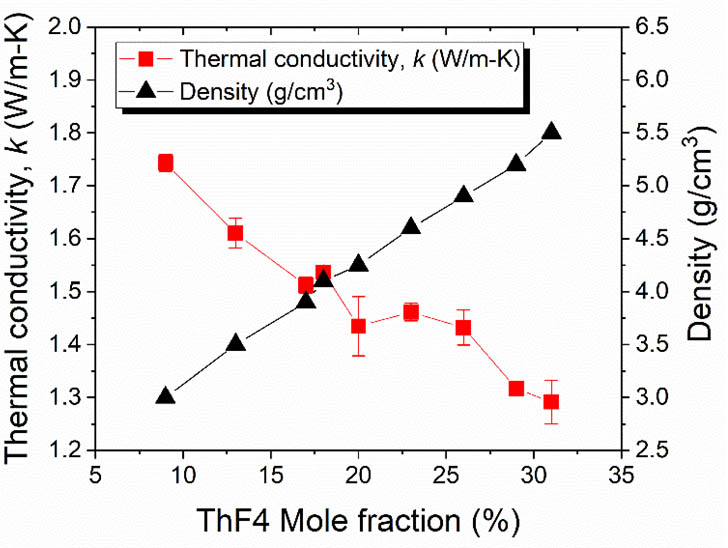
Thermal conductivity and density of LiF-ThF4 as a function of ThF4 mole fraction at 1000 K. -
Fracture of Graphene by Impact
Graphene is a single layer of graphite and is expected to be the strongest material found in history. We investigate the fracture toughness of graphene using molecular dynamics simulations.
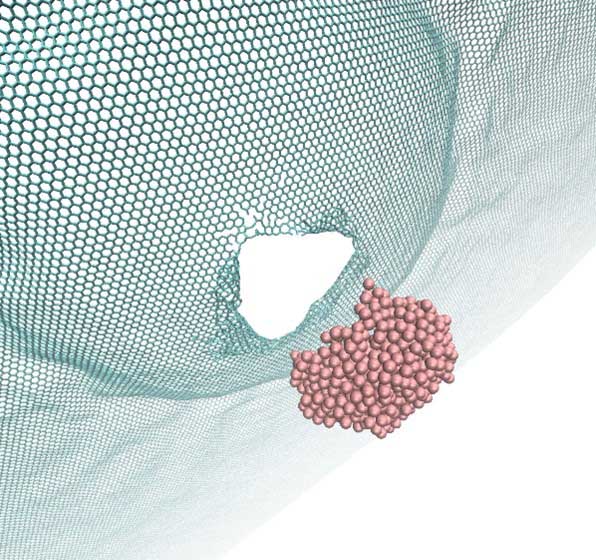
A silver nanoparticle is breaking a single layer graphene sheet. -
Understanding Pathogen Dispersion under UV Light
Water acts as a transport mechanism for many microorganisms, including Escherichia coli (E. coli). E. coli when present in a water source poses health risk to consumers. Ultraviolet (UV) radiation is a technology widely used in disinfection of microorganisms and shows promising potentially to be applied to water and surface disinfection. However, studies and specific details regarding the UV radiation technology has thus far mainly been kept proprietary. This study will attempt to numerically study the potential use of UV source in disinfecting E. Coli in moving liquid. In the numerical study, a 0.9 m long, 65 Watts UV light source was used at the top, midpoint length of a 2.7m long and 0.2m wide channel. The E. coli source was placed at the bottom midpoint of the channel. With water entering and exiting the channel, preliminary simulation result show that the spread and trajectory of E. Coli in moving water on a flat surface, with the present of ultraviolet light directly above the source, can be altered and areas with critical mass of pathogens can be identified. The outcome of this study may aid in design of more efficient water disinfection system in the future.

a) Normalized pathogen concentration without UV influence and figure. b) Normalized pathogen concentration with UV influence. -
Tracking Small Insects using Transparent Omnidirectional Locomotion Compensator (TOLC)
Most behavior studies in small insects such as a fruit fly (Drosophila Melanogaster) and an ant have been performed in a limited spatial chamber or by tethering its body on a fixture, which restricts its natural behavior. We are developing the tracking system for these small insects, which enables its navigation without any motion restrictions. For a fruit fly, the transparent sphere is being used to compensate motion of a freely walking fly without physical tethering. These instruments minimize potential injury or damages during the longitudinal experiment. These will greatly expand the repertoire of natural behaviors that can be studied with cellular resolution calcium imaging, including spatial navigation, social behavior, feeding, and reward. In addition, we are investigating the effects of radiation on these animals’ locomotion in real-time.
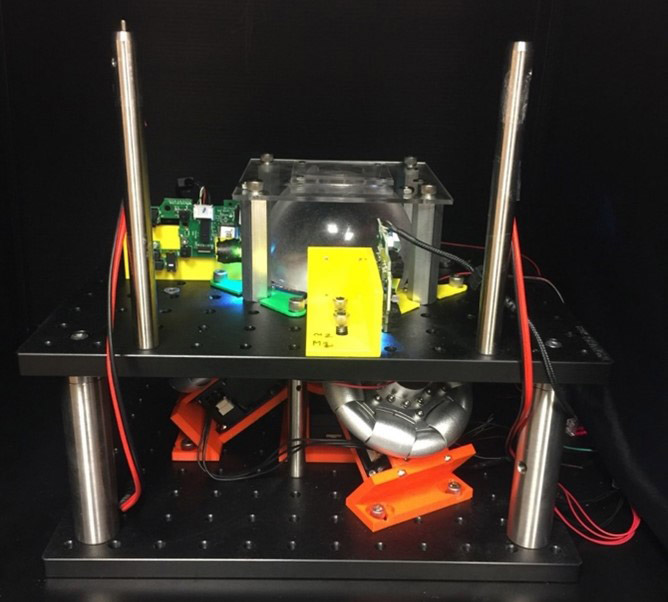
Transparent Omnidirectional Locomotion Compensator (TOLC) for small insects -
Magnetically Controllable Miniaturized Swimming Robot
Understanding behaviors in animals is challenging because it is governed by complex interaction with other animals and the environment. Recently, the Ethorobotics, an interdisciplinary research area at the interface of robotics and ethology, has been highlighted, which enables us to investigate interactive behavior extensively using a robotic system. The integration of the biological creature and robotic systems, both physically and cognitively, becomes a new promising paradigm of conventional biological research. However, limited ethorobotic approaches have been utilized for measuring behaviors in small-scale animals such as a larval zebrafish due to the difficulty in developing limited size robots. We are studying fabrication and control of a magnetic-controllable miniaturized swimming robot that interacts with a small larval fish using the magnetic particle embedded soft polymer.
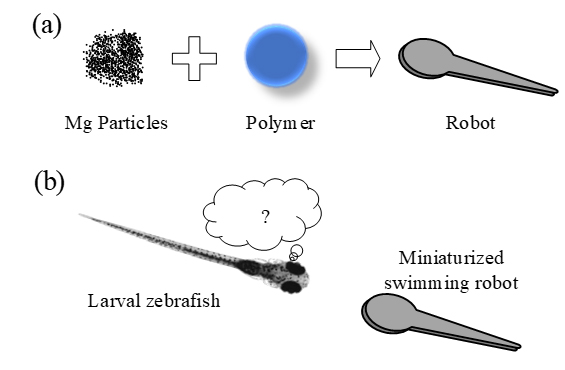
A miniaturized swimming robot. (a) Fabrication of a swimming robot, which consists of magnetic particles and soft polymer (b) Interaction between a larval zebrafish and a miniatured swimming robot. -
Cell migration
Cell migration, a critical process for morphogenesis, immune response, wound healing, tissue regeneration, and cancer metastasis, is a highly coordinated process involving intracellular and extracellular biophysical properties. Depending on the physical environment in which cells reside, cells can utilize different mechanisms to migrate, such as actin polymerization or water flux. A mathematical model has been developed to determine various mechanisms of force generation behind cell migration. The model contains two fluid phases, cytosol and actin network, and solute diffusion. The model predictions will provide insights into how cells in vivo develop their migratory strategies
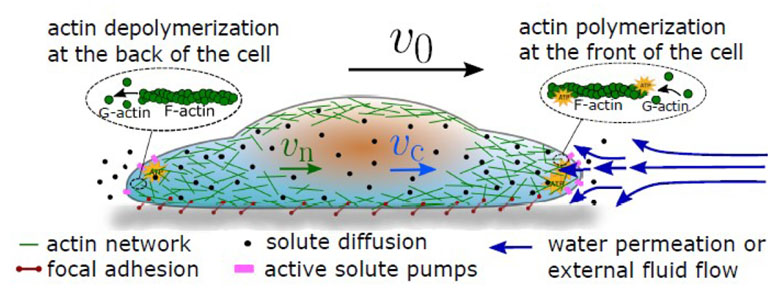
A diagram of a two-phase cell migration model where the cytosol and the actin network are equally treated. Both water flux and actin polymerization can affect cell migration. -
Ion channels and cell volume control
Cells actively control their volume and ionic content to maintain proper functions. Cell volume is regulated by water permeation across the cell membrane, and the ionic content is regulated by ion channels and pumps. The chemical-potential difference of water across the membrane is determined by the osmotic and hydrostatic pressure across the cell. The hydrostatic pressure difference is also related to the cortical tension of the cell. These create strong coupling among osmosis, cell volume, ion channel activities, hydrostatic pressure, and cortical tension. I develop mathematical models to identify the physical processes that control the couplings.
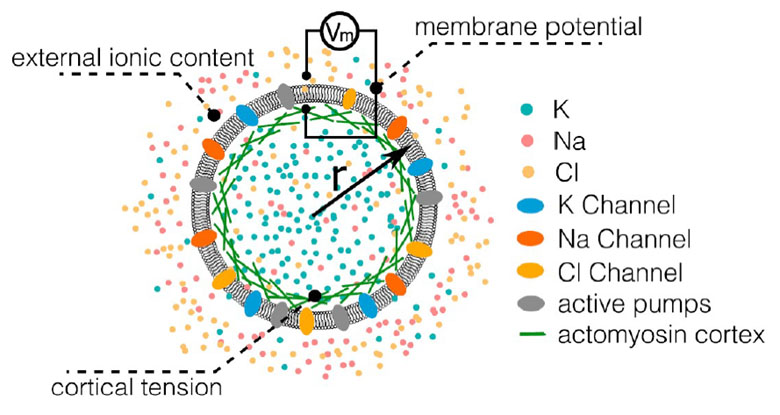
A diagram of a suspension cell with various ion species and the associated channels and pumps. The channels and pumps can regulate cell volume. -
Learning to Learn Engineering
This research endeavors to illuminate the learning process itself along with development of learning skills in engineering students. This work builds understanding of the various components a framework for engineering learner development that leverages processes allowing learners to learn more effectively, i.e., learning to learn engineering.
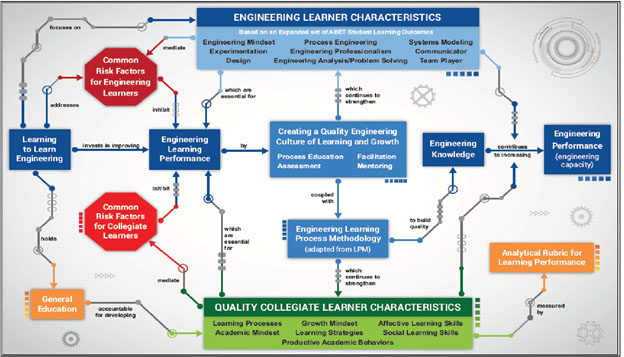
-
Process Education Methodologies
This theoretical research revolves around the development methodologies that can be used to enhance learning and to spur growth of learning capabilities. Key methodologies include the learning process methodology (especially as adapted to engineering, the methodology for generalizing knowledge, and the performance development methodology).
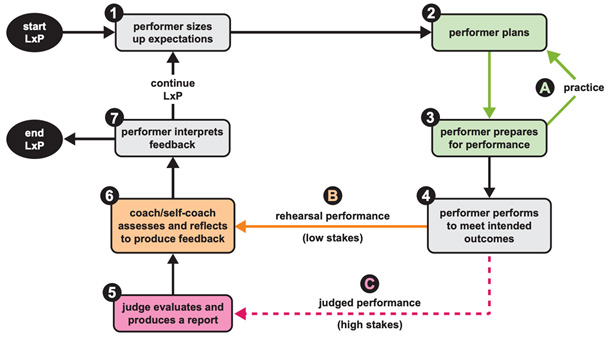
Process Stages within Performance Improvement -
Learning experiences using 3D printed laboratory equipment (3D-PLE)
This work consists of designing and experimentally testing learning activities (based on appropriate learning theory) to maximize the benefits of incorporating 3D-PLE systems into lecture and lab courses. Three learning theories are central to these learning activity designs: expectancy-value theory to enhance motivation, growth mindset theory to improve student performance, and social constructivist theory to leverage collaborative learning.
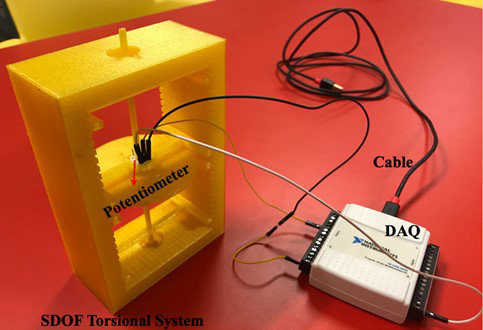
-
Faculty Development in Scholarly TeachingThis work relates to studying faculty adoption of new pedagogical techniques into their teaching repertoire. This involves understanding what motivates their approach to teaching, the impact of the learning culture in engineering on what is viewed as relevant, and what types of changes faculty are willing to spend time pursuing in their teaching either on their own or with colleagues.







